Abstract
The immunoglobulin (Ig) class and IgG subclasses of autoantibodies to commercial VDRL antigen, creatine kinase (CK), and fibronectin (Fn) in the sera of patients with various stages of syphilis were quantified using solid-phase radioimmunoassays (RIA) and ELISA. Sera from patients with active secondary syphilis, initially positive for anti-Fn and anti-CK autoantibodies by RIA, were re-evaluated by ELISA using monoclonal antibodies (MoAb) for detection of human Ig class and subclass responses. Results of these assays revealed that anti-Fn and anti-CK responses were not only IgG in nature, but dramatically skewed to IgG1 and IgG3 subclasses. While the restricted, co-expression of these isotypes seemingly paralleled anti-treponemal activity, inverse relationships actually existed between the subclass responses to Fn and those to Treponema pallidum. In contrast, anti-VDRL were predominantly IgM in 17 of 22 patients. Of those sera exhibiting detectable anti-VDRL IgG activity, responses appeared to be restricted to IgG1. These results suggest that different control mechanisms may be responsible for regulation of the various autoantibody responses expressed during syphilitic infection.
Full text
PDF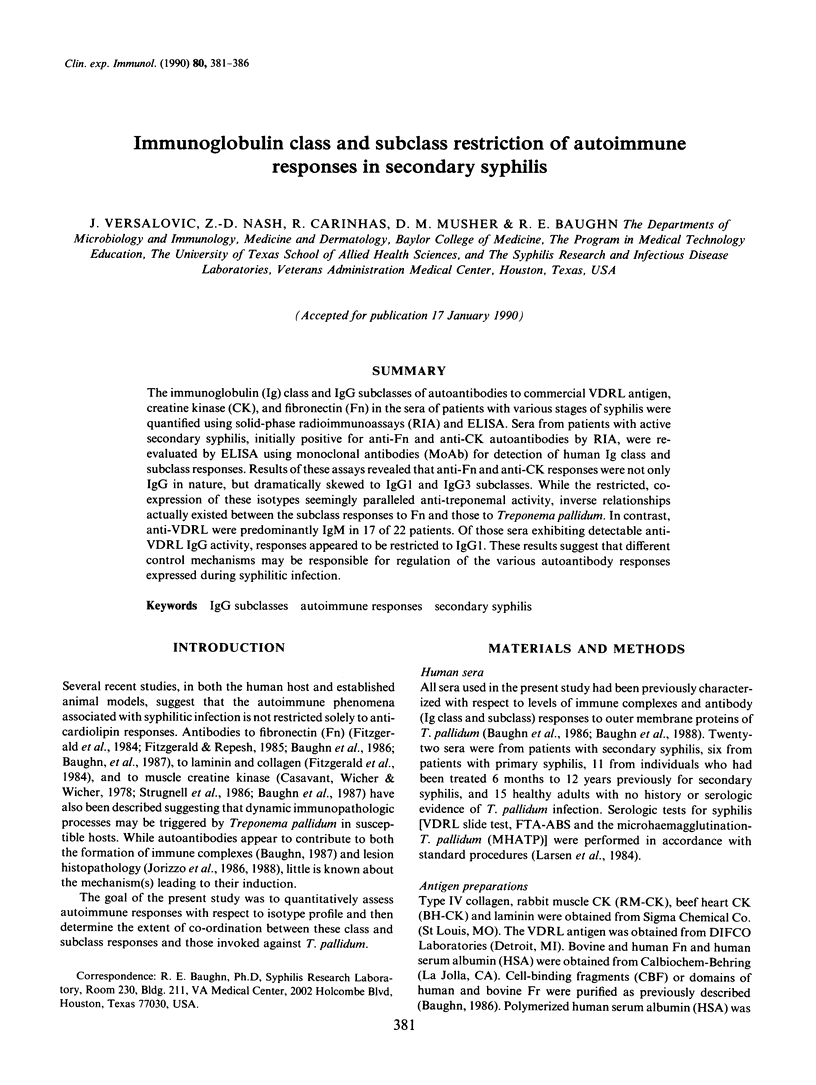
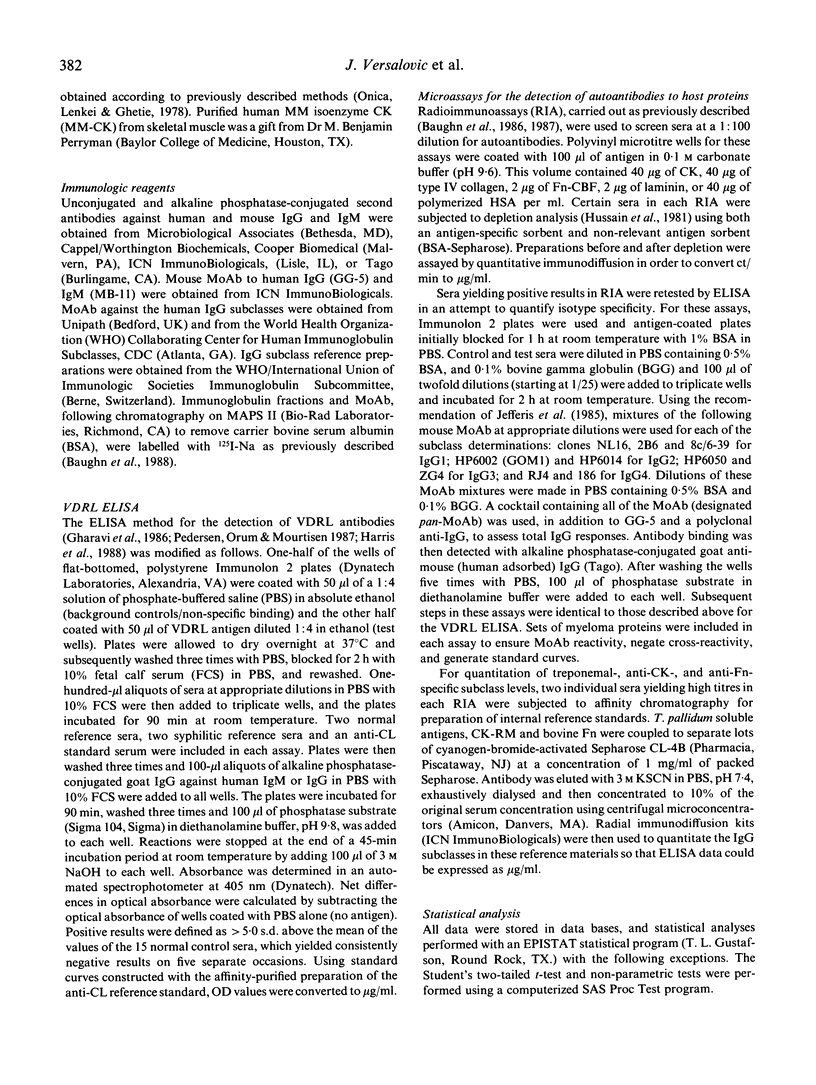
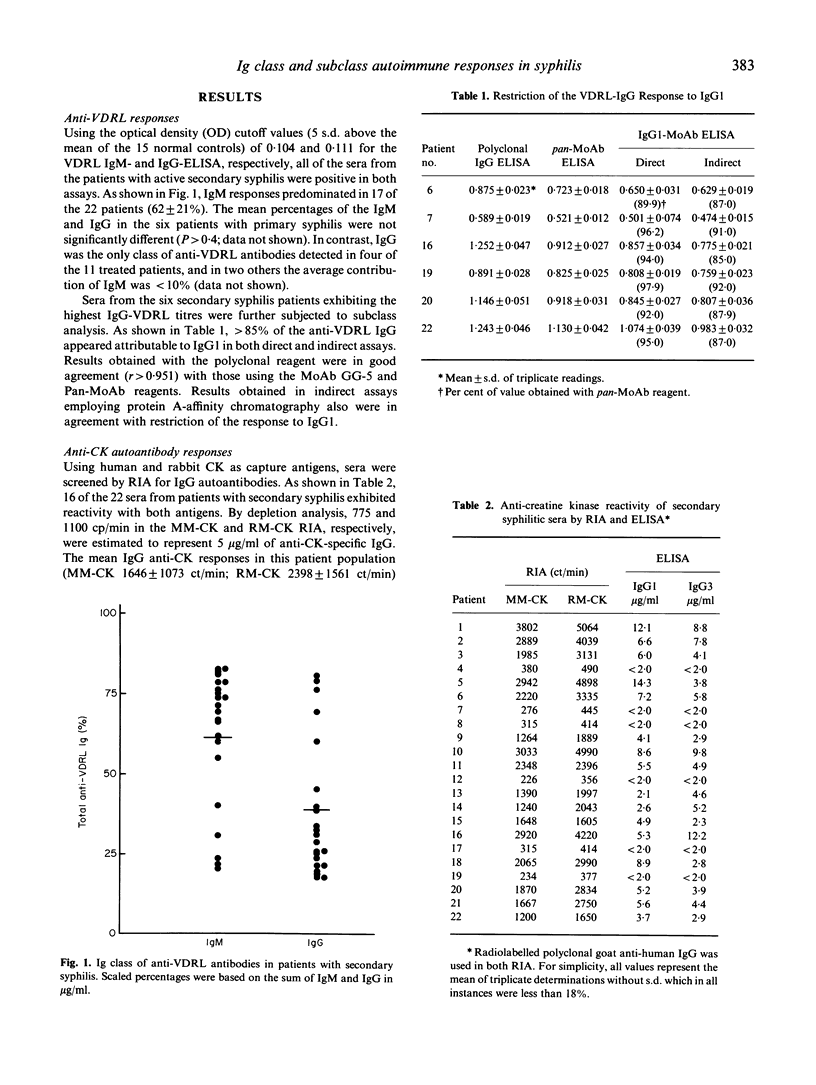
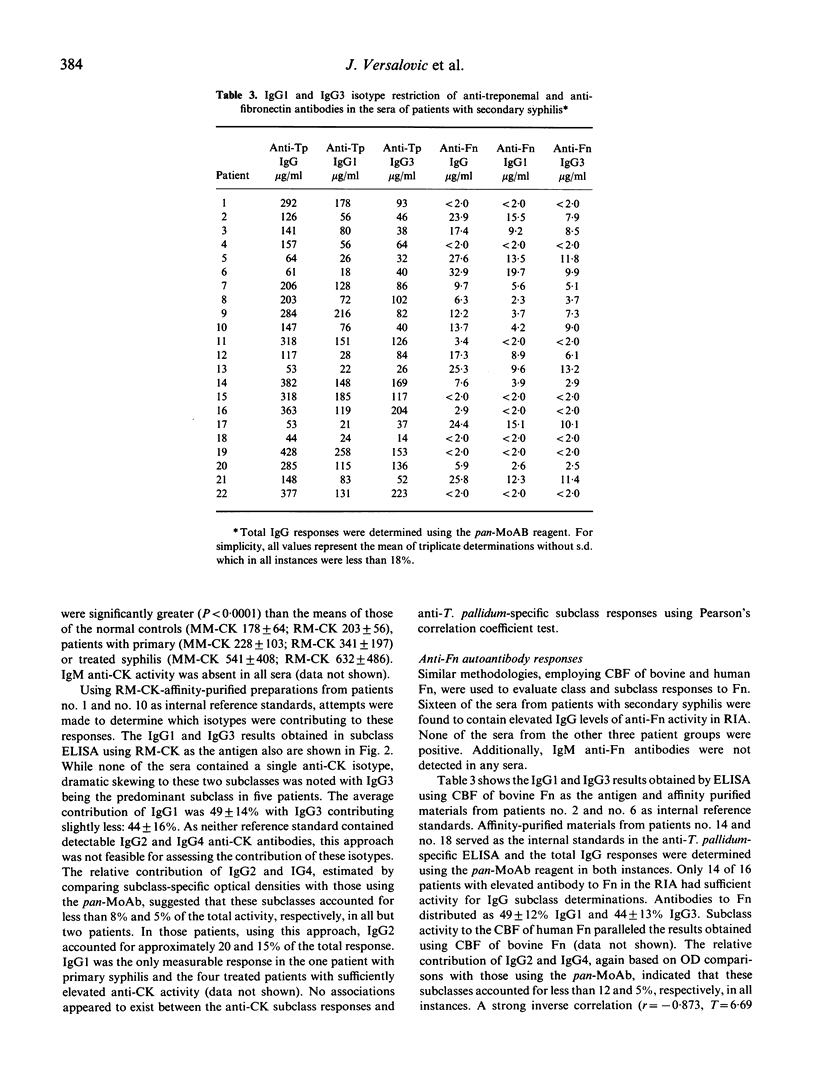
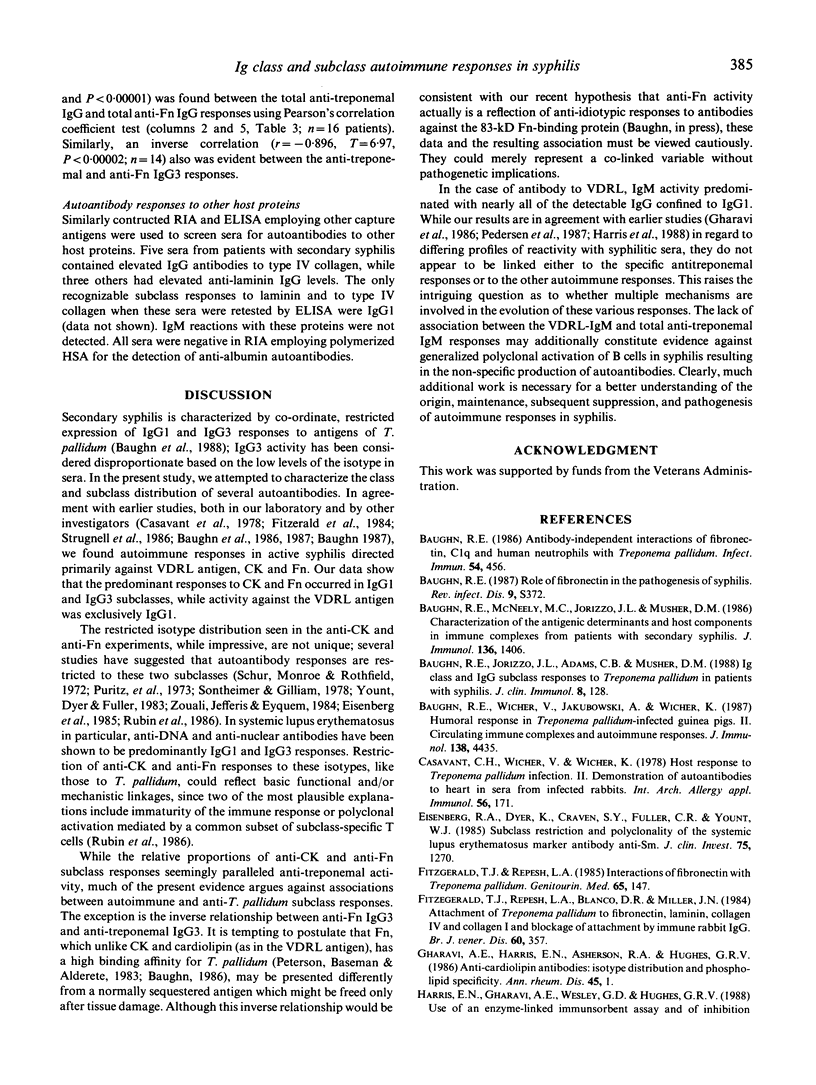
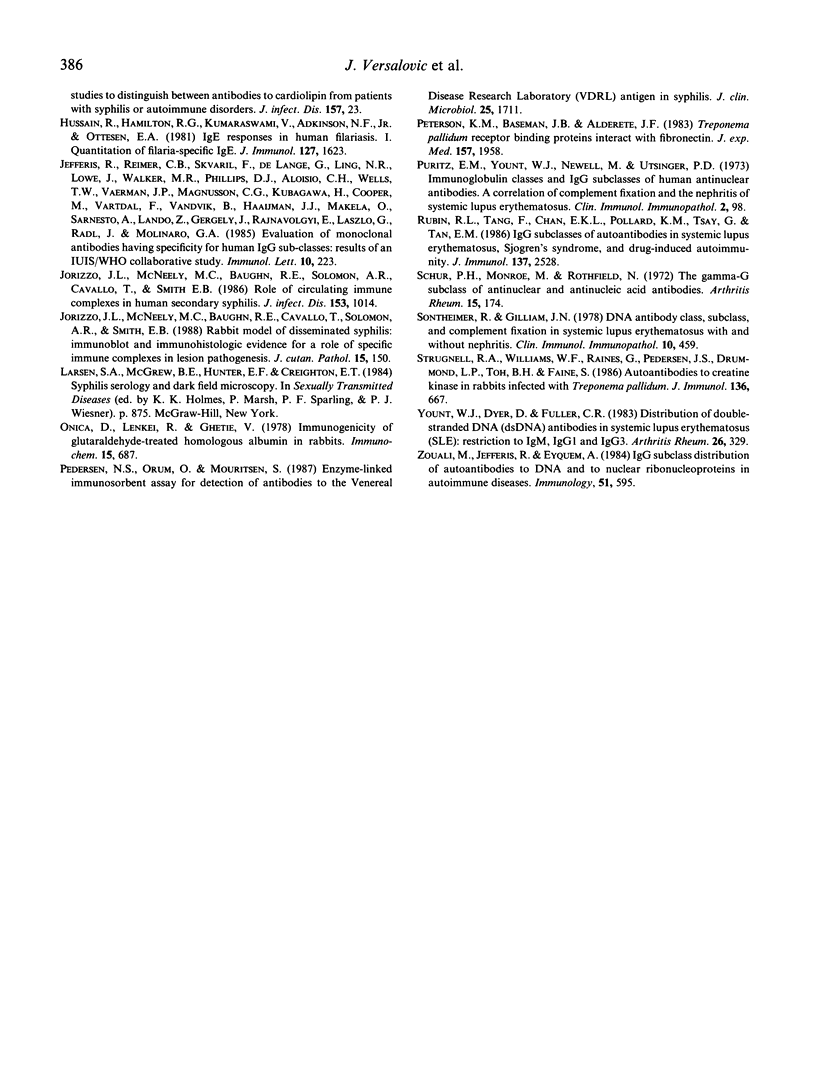
Selected References
These references are in PubMed. This may not be the complete list of references from this article.
- Baughn R. E. Antibody-independent interactions of fibronectin, C1q, and human neutrophils with Treponema pallidum. Infect Immun. 1986 Nov;54(2):456–464. doi: 10.1128/iai.54.2.456-464.1986. [DOI] [PMC free article] [PubMed] [Google Scholar]
- Baughn R. E., Jorizzo J. L., Adams C. B., Musher D. M. Ig class and IgG subclass responses to Treponema pallidum in patients with syphilis. J Clin Immunol. 1988 Mar;8(2):128–139. doi: 10.1007/BF00917901. [DOI] [PubMed] [Google Scholar]
- Baughn R. E., McNeely M. C., Jorizzo J. L., Musher D. M. Characterization of the antigenic determinants and host components in immune complexes from patients with secondary syphilis. J Immunol. 1986 Feb 15;136(4):1406–1414. [PubMed] [Google Scholar]
- Baughn R. E. Role of fibronectin in the pathogenesis of syphilis. Rev Infect Dis. 1987 Jul-Aug;9 (Suppl 4):S372–S385. doi: 10.1093/clinids/9.supplement_4.s372. [DOI] [PubMed] [Google Scholar]
- Baughn R. E., Wicher V., Jakubowski A., Wicher K. Humoral response in Treponema pallidum-infected guinea pigs. II. Circulating immune complexes and autoimmune responses. J Immunol. 1987 Jun 15;138(12):4435–4440. [PubMed] [Google Scholar]
- Casavant C. H., Wicher V., Wicher K. Host response to Treponema pallidum infection. III. Demonstration of autoantibodies to heart in sera from infected rabbits. Int Arch Allergy Appl Immunol. 1978;56(2):171–178. [PubMed] [Google Scholar]
- Eisenberg R. A., Dyer K., Craven S. Y., Fuller C. R., Yount W. J. Subclass restriction and polyclonality of the systemic lupus erythematosus marker antibody anti-Sm. J Clin Invest. 1985 Apr;75(4):1270–1277. doi: 10.1172/JCI111826. [DOI] [PMC free article] [PubMed] [Google Scholar]
- Fitzgerald T. J., Repesh L. A., Blanco D. R., Miller J. N. Attachment of Treponema pallidum to fibronectin, laminin, collagen IV, and collagen I, and blockage of attachment by immune rabbit IgG. Br J Vener Dis. 1984 Dec;60(6):357–363. doi: 10.1136/sti.60.6.357. [DOI] [PMC free article] [PubMed] [Google Scholar]
- Fitzgerald T. J., Repesh L. A. Interactions of fibronectin with Treponema pallidum. Genitourin Med. 1985 Jun;61(3):147–155. doi: 10.1136/sti.61.3.147. [DOI] [PMC free article] [PubMed] [Google Scholar]
- Hamilton E. B. George Frederic Still. Ann Rheum Dis. 1986 Jan;45(1):1–5. doi: 10.1136/ard.45.1.1. [DOI] [PMC free article] [PubMed] [Google Scholar]
- Harris E. N., Gharavi A. E., Wasley G. D., Hughes G. R. Use of an enzyme-linked immunosorbent assay and of inhibition studies to distinguish between antibodies to cardiolipin from patients with syphilis or autoimmune disorders. J Infect Dis. 1988 Jan;157(1):23–31. doi: 10.1093/infdis/157.1.23. [DOI] [PubMed] [Google Scholar]
- Hussain R., Hamilton R. G., Kumaraswami V., Adkinson N. F., Jr, Ottesen E. A. IgE responses in human filariasis. I. Quantitation of filaria-specific IgE. J Immunol. 1981 Oct;127(4):1623–1629. [PubMed] [Google Scholar]
- Jefferis R., Reimer C. B., Skvaril F., de Lange G., Ling N. R., Lowe J., Walker M. R., Phillips D. J., Aloisio C. H., Wells T. W. Evaluation of monoclonal antibodies having specificity for human IgG sub-classes: results of an IUIS/WHO collaborative study. Immunol Lett. 1985;10(3-4):223–252. doi: 10.1016/0165-2478(85)90082-3. [DOI] [PubMed] [Google Scholar]
- Jorizzo J. L., McNeely M. C., Baughn R. E., Cavallo T., Solomon A. R., Smith E. B. Rabbit model of disseminated syphilis: immunoblot and immunohistologic evidence for a role of specific immune complexes in lesion pathogenesis. J Cutan Pathol. 1988 Jun;15(3):150–160. doi: 10.1111/j.1600-0560.1988.tb00535.x. [DOI] [PubMed] [Google Scholar]
- Jorizzo J. L., McNeely M. C., Baughn R. E., Solomon A. R., Cavallo T., Smith E. B. Role of circulating immune complexes in human secondary syphilis. J Infect Dis. 1986 Jun;153(6):1014–1022. doi: 10.1093/infdis/153.6.1014. [DOI] [PubMed] [Google Scholar]
- Onică D., Lenkei R., Gheţie V. Immunogenicity of glutaraldehyde-treated homologous albumin in rabbits. Immunochemistry. 1978 Sep;15(9):687–693. doi: 10.1016/0161-5890(78)90043-3. [DOI] [PubMed] [Google Scholar]
- Peterson K. M., Baseman J. B., Alderete J. F. Treponema pallidum receptor binding proteins interact with fibronectin. J Exp Med. 1983 Jun 1;157(6):1958–1970. doi: 10.1084/jem.157.6.1958. [DOI] [PMC free article] [PubMed] [Google Scholar]
- Puritz E. M., Yount W. J., Newell M., Utsinger P. D. Immunoglobulin classes and IgG subclasses of human antinuclear antibodies. A correlation of complement fixation and the nephritis of systemic lupus erythematosus. Clin Immunol Immunopathol. 1973 Nov;2(1):98–113. doi: 10.1016/0090-1229(73)90040-8. [DOI] [PubMed] [Google Scholar]
- Rubin R. L., Tang F. L., Chan E. K., Pollard K. M., Tsay G., Tan E. M. IgG subclasses of autoantibodies in systemic lupus erythematosus, Sjogren's syndrome, and drug-induced autoimmunity. J Immunol. 1986 Oct 15;137(8):2528–2534. [PubMed] [Google Scholar]
- Schur P. H., Monroe M., Rothfield N. The gammaG subclass of antinuclear and antinucleic acid antibodies. Arthritis Rheum. 1972 Mar-Apr;15(2):174–182. doi: 10.1002/art.1780150206. [DOI] [PubMed] [Google Scholar]
- Sontheimer R. D., Gilliam J. N. DNA antibody class, subclass, and complement fixation in systemic lupus erythematosus with and without nephritis. Clin Immunol Immunopathol. 1978 Aug;10(4):459–467. doi: 10.1016/0090-1229(78)90158-7. [DOI] [PubMed] [Google Scholar]
- Strugnell R. A., Williams W. F., Raines G., Pedersen J. S., Drummond L. P., Toh B. H., Faine S. Autoantibodies to creatine kinase in rabbits infected with Treponema pallidum. J Immunol. 1986 Jan;136(2):667–671. [PubMed] [Google Scholar]
- Zouali M., Jefferis R., Eyquem A. IgG subclass distribution of autoantibodies to DNA and to nuclear ribonucleoproteins in autoimmune diseases. Immunology. 1984 Mar;51(3):595–600. [PMC free article] [PubMed] [Google Scholar]


